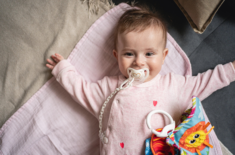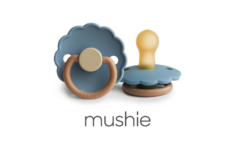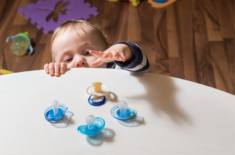Overview
Numerous studies have shown that pacifier use can significantly reduce the risk of SIDS (sudden infant death syndrome), particularly when used for sleeping. (1)(2)
Many researchers even recommend encouraging pacifier use because it can be beneficial population-wide. Pacifiers are considered by many parents as must-have baby essentials. (1)
Even though some studies haven’t found baby pacifiers (binky, paci, soothie, or dummy) effective against SIDS, the AAP (American Academy of Pediatrics) recognizes their potential. They have recommended pacifier use as far back as 2005. (2)(3)
But what if your baby doesn’t like the binky, will that still be safe in terms of SIDS? What strategies can you try to encourage them use it? Should you force them to take it? What baby-soothing techniques can you teach them if they really won’t take a pacifier?
You can find answers below.
Why Do Pacifiers Work?
Babies use pacifiers for non-nutritive sucking, an action that isn’t actually linked to easing their hunger but more as a form of soothing.
Your newborn baby will associate pacifier use with the comfort they felt in your womb.
Why Will My Baby Not Take A Pacifier?
There can be several reasons why your little one won’t take a pacifier, but often, it might be due to its different shape, taste, and form compared to your nipples.
Is It Common For Babies To Not Like Pacifiers?
Yes. Don’t worry if your baby doesn’t like pacifiers because that’s actually a common thing, especially with breastfed babies.
Is It Dangerous For Babies Not To Use Pacifiers?
Well, not really. Although pacifiers can reduce SIDS risks, their use doesn’t guarantee it won’t happen. Also, your baby isn’t likely to have an increased risk of SIDS if they don’t use pacifiers.
In fact, some studies have even reported that they didn’t find significant evidence to support or refute pacifier use as a measure against SIDS. (3)
Common Problems With Pacifier Use
Baby Doesn’t Like Pacifiers
Some babies refuse to take the pacifier right from the start and continue to refuse it. Although many will eventually take a pacifier with encouragement and tricks, some won’t ever accept the paci.
If your baby refuses to take a binky but can soothe themselves (other than thumbsucking), other moms might call you a lucky mama.
Baby Latches Onto The Pacifier Incorrectly
Breastfed babies open their mouths wide to feed. So, they might get confused over how to latch onto a pacifier because it’s small and doesn’t feel as wide as mommy’s boob.
Baby Takes The Pacifier For A Few Weeks, Then Stops
Some babies might learn to take a pacifier but refuse to use it again after a few weeks.
You can take cues from your baby, mama. If they don’t like the pacifier and won’t take one despite numerous attempts, then let them be.
Your new baby doesn’t require a binky. This might even be ideal because prolonged pacifier use has been linked to ear infections and problems with your baby’s teeth. (4)(5)
12 Tips To Get Your Baby To Take A Pacifier
For many moms, pacifier use is better than thumbsucking because it’s easier to get rid of the binky once it’s time to wean the little one. The reduced SIDS risk is a bonus.
So, if your fussy baby refuses to take the pacifier, you might want to try the following tips:
1. Let Them Play & Introduce It “For Fun”
A pacifier has a different shape, size, and texture than your boob or bottle nipples. So, it’s understandable that your baby might be confused about how to use it.
You can introduce the pacifier by letting them play with it.
The downside to doing this is that they might associate toys with things to put in their mouth. Although babies tend to do that, encouraging them to do it by teaching them to use the pacifier in this manner could lead them to like putting things in their mouths more.
2. Add Some Breast Milk Or Formula (Never Use Honey Or Sugar)
The pacifier’s nipple taste can seem strange to your baby if they’re using it for the first time. You can help introduce it by coating it with some breast milk or formula.
Your little one is more likely to take the pacifier if it tastes like something they’re familiar with.
Warning: Never use honey or sugar!
Even if you want your baby to take the pacifier, never coat it with honey or sugar.
Honey shouldn’t be given to anyone under 12 months of age because it puts them at risk for infant botulism, a potentially deadly condition caused by toxins produced by the Clostridium botulinum bacteria. (6)
Both honey and sugar can increase your child’s risk for tooth decay. (7)
Plus, added sugars aren’t recommended for children younger than two years because these can increase their risk of obesity. (8)
3. Find The Right Time (Offer Only After Feedings)
Your baby could get frustrated if you give the pacifier when they’re hungry, because they might expect milk to come out of it.
It’s better to introduce it after feedings when your baby is full and content. The pacifier can fill their non-nutritive sucking needs and also help improve their sucking reflexes.
4. Pretend Like You’re Nursing Them
Some new moms mimic breastfeeding to encourage their baby to take the pacifier.
Your little one might be confused or surprised at the sudden shift of the wide boob to this little paci, but they may be more likely to try it than when you give it to them out of the blue.
5. Reverse Psychology
Reverse psychology might work for some babies who continue to refuse the pacifier or repeatedly spit it out of their mouths.
When they actually have the pacifier in their mouth, give it a small tug as if you’re taking it away. Most babies take that as a challenge and will naturally try to put up some resistance to the new sensation.
By encouraging them to keep sucking, you get them to hold on to the pacifier.
6. Try The “Sneaky” Way
You can quickly switch the boob or bottle nipple to the pacifier when you notice your baby is full. Your baby will most likely continue sucking out of reflex.
7. Turn Your Baby’s Attention To The Binky(Try Tapping & Shaking)
Insert the pacifier into your baby’s mouth, then give it a little tap or shake. This action activates their sucking reflex.
8. Make It More Comfortable To Take (Warm The Nipple)
Your baby might refuse the pacifier if it feels cold or even icky. Try to warm the nipple or check whether it’s sticky (rubber pacifiers tend to become sticky when exposed to heat).
9. Try The Sleep & Switch
If your little one falls asleep during feeding, you can try replacing your boob or bottle nipple with the pacifier. Give it a little tap and let your baby’s sucking reflex kick in.
10. Be Patient & Keep Trying
It could take some time before your baby will take the pacifier. Just be patient and keep trying until they do it.
11. Consider Your Little One’s Health
You might also consider checking your baby’s health or condition if everything else fails.
Some teething kids might not like getting their gums touched by something, although others are more likely to bite on the pacifier or anything to ease their discomfort.
If your baby cries or shows discomfort when you put a pacifier in their mouth (and when they’re feeding), check for possible mouth sores and signs of thrush (yeast infection). These need treatment so your baby will feel better.
12. Try Different Varieties
Different pacifiers have varied designs, shapes, and textures. It’s possible that your baby doesn’t like the first one you got but might like other options.
For first-time paci users, it could take a few trials before you find the right one they’ll take.
Different Types Of Pacifiers
Material
Common materials used for pacifier nipples:
- Silicone
- Latex or rubber
Silicone pacifiers can be the better option because the material is hypoallergenic.
They’re also sturdier, don’t retain odors, and are usually dishwasher-safe (top rack). However, silicone binkies aren’t as soft as rubber or latex pacifiers.
In contrast, rubber and latex pacifiers are usually softer, more flexible, and cheaper. However, they’re more prone to breaking down faster and can become sticky if heated, so they usually can’t be boiled or sterilized.
Some babies are allergic to latex, but silicone isn’t an allergen.
Watch out for these symptoms of latex allergy: (9)
- Rash
- Sneezing
- Runny nose
- Skin redness
- Wheezing
- Cough
- Hives
- Itchy and/or watery eyes
- Itchy skin, lips, or mouth
- Scratchy throat
Severe cases of latex allergy can lead to: (9)
- Dizziness
- Difficulty breathing
- Vomiting
- Nausea
- A drop in blood pressure
- Confusion
- Loss of consciousness
- Rapid or weak pulse
It’s always best to check for pacifiers labeled as BPA-free or phthalate-free. These toxic chemicals have been linked to altered reproductive function, lower IQ, cancer, diabetes, and asthma. (10)(11)
The good news is that most (possibly all) manufacturers are no longer using BPA and phthalates in making latex and silicone baby products. But it’s still good to check the pacifier packaging just to be sure.
Shape
Manufacturers make pacifiers in different shapes and styles to meet your little one’s needs.
Different nipple shapes to try:
- Round – the most common nipple shape, usually with a straight, elongated nipple, but also available with a ball-shaped tip
- Orthodontic pacifiers – helps keep the pacifier in the correct position in your baby’s mouth
- Flat – mimics a mom’s natural nipple shape
Some binkies are also designed to double as a teether, while others are attached to a stuffed toy (sometimes called a lovey) for your baby to cuddle.
Size
Most manufacturers offer pacifiers in different sizes. Choose the ones designed for your baby’s age and size to avoid choking risks and other safety issues.
Tiny pacifiers are made for preemies and newborns, but these binkies can potentially be a choking risk for babies older than two months old.
However, newborns and preemies might find larger pacifiers too big during their first month. The shield might even potentially cover their nose.
Always check the packaging for the right pacifier size and recommended ages.
Design
Choosing a one-piece pacifier is a good idea to reduce the choking risk if the multiple parts break down into smaller, separate pieces.
Pacifiers with a shield can also be a good choice to further reduce choking risks. The shield size recommendation is at least 1½ inches across. This prevents your baby from taking the entire paci in their mouth. (12)
Just make sure that the shield has at least one ventilation hole per side to allow air circulation. Without these holes, your baby’s saliva could collect behind the base and possibly cause a skin rash or irritation.
What’s The Best Pacifier For Breastfed Babies?
Here are some of the best pacifiers you can choose for your breastfed little one:
- Chicco PhysioForma mi-cro Orthodontic Pacifier
- Philips Avent Ultra Air Nighttime Pacifier
- Tommee Tippee Closer to Nature Breast-Like Pacifier
- Dr. Brown’s HappyPaci Pacifier with Lovey Soft Toy Holder
- Nanobebe Baby Flexy Pacifier
- Itzy Ritzy Sweetie Soother
- TOMY Boon JEWL Orthodontic Silicone Pacifier
- Ryan & Rose Cutie Pat (Slant) 2-in-1 Pacifier and Teether
- Wubbanub Pacifier
- Doddle & Co. The Pop Silicone Pacifier
- Nuk Airflow Pacifier
- MAM Perfect Pacifier
How To Keep The Binky In Your Baby’s Mouth
While sleeping, your baby might spit out the pacifier. You can put it back in, then give it a little tap to activate your baby’s sucking reflex to keep it in their mouth.
Never put cords, strings, or anything that can cause a strangulation risk to keep the pacifier from falling off. Use a short pacifier clip if necessary.
Some parents also find a lovey (such as a stuffed animal) more effective in keeping the pacifier from falling, but avoid using this for your sleeping baby (especially preemies and newborn babies).
For their safety, keep your baby’s sleep area free from possible breathing obstructions and strangulation risks.
Life Without A Pacifier (A Pacifier Isn’t Always Required)
While a pacifier can have benefits and is certainly a convenience for parents, it isn’t a requirement. Your baby will be alright even if they don’t take it.
You can always find other ways to soothe your baby while also discouraging them from thumbsucking, which can be a rather difficult habit to break.
Like prolonged pacifier use, thumbsucking can also cause problems to your baby’s teeth, especially if they still do it when they’re over a year old.
The Pros & Cons Of Pacifier Use
Upsides & Benefits Of Pacifiers
- Pacifiers may reduce SIDS risk
- Pacifiers can soothe and distract
- Pacifiers can help your baby sleep better and longer
- Pacifiers can help with air travel
Downsides & Cons
- Pacifiers might increase the risks of ear infection (4)
- Pacifiers could cause problems with your baby’s teeth alignment with prolonged use (5)
When To Introduce A Binky
What’s The Right Age For A Pacifier?
You can offer a pacifier to most newborn babies, although you might reconsider if you’re breastfeeding.
Studies show that pacifiers are beneficial for preemies and could speed up their transition from tube to oral feeding. However, if your baby is born prematurely, be sure to ask your pediatrician before giving them one for their safety. (13)
Breastfed Babies
Nipple confusion (your baby experiences breastfeeding problems after using a binky or formula bottle) might be a problem if you’re breastfeeding. Your milk supply might be affected if your baby refuses to feed.
Before giving them a pacifier, you can wait until breastfeeding is well established, usually around 3-4 weeks after birth.
Bottle-fed Babies
You don’t need to worry about or experience nipple confusion if you’re bottle-feeding (with pumped breast milk or infant formula). So, you can give a pacifier to your child, whether for short naps or nighttime sleep.
Related FAQs
How Can I Soothe My Baby Who Won’t Take A Pacifier?
You can try the following ways to soothe your fussy baby:
- Singing
- Rocking
- Cuddling
- Picking them up
If your baby still doesn’t stop crying, try to find the reason for their discomfort. Possible options can include:
- Hunger
- Need for a diaper change
- Tummy ache from bloating, colic, constipation, or other problems
- Fever or colds
How Do I Teach My Baby To Self-Soothe?
- Create a quiet, dark, and cool sleep environment for their nursery
- Establish their bedtime routine
- Give your baby sleep cues (e.g., reading a book or taking a bath)
- Start sleep training and be consistent
- Try to move their feeding schedule away from bedtime
- Encourage them with soothing words and an occasional back rub
When To Start Weaning Your Little One From The Pacifier?
The AAP and the AAFP (American Academy of Family Physicians) both recommend weaning your little one from pacifiers starting at six months of age to help reduce the risk of ear infections. (14)
What To Do With A Pacifier Withdrawal?
If your baby is used to a pacifier, they might cry a lot if you try to wean them off it.
You can teach them the self-soothing techniques above, but try to discourage them from turning to thumbsucking, which can be more difficult to stop.
Should I Force Pacifier Use?
No. Take your baby’s cues. If they continue to refuse to take it, you don’t have to force the issue. They might prefer other soothing techniques.
What Are The Safe & Best Ways To Use A Pacifier?
- Always use clean, sanitized pacifiers (you can sanitize them with your baby bottles).
- Never coat your baby’s pacifier with honey or sugar.
- Never put strings or cords that can become strangulation risks on your baby’s pacifier.
- You can choose one-piece pacifiers to avoid choking risks if the separate parts (in multiple-piece pacifiers) break apart.
- Always check for pacifier recalls and safety alerts.
REFERENCES
(1) https://pubmed.ncbi.nlm.nih.gov/16216900/
(2) https://www.ncbi.nlm.nih.gov/pmc/articles/PMC3961164/
(3) https://www.ncbi.nlm.nih.gov/pmc/articles/PMC7286729/
(4) https://pubmed.ncbi.nlm.nih.gov/11979200/
(5) https://www.mouthhealthy.org/~/media/ada/publications/files/patient_77.pdf?la=en
(6) https://kidshealth.org/en/parents/botulism.html
(7) https://www.cdc.gov/nutrition/infantandtoddlernutrition/foods-and-drinks/foods-and-drinks-to-limit.html
(8) https://www.dietaryguidelines.gov/sites/default/files/2020-12/Dietary_Guidelines_for_Americans_2020-2025.pdf
(9) https://www.mayoclinic.org/diseases-conditions/latex-allergy/symptoms-causes/syc-20374287
(10) https://www.mayoclinic.org/healthy-lifestyle/nutrition-and-healthy-eating/expert-answers/bpa/faq-20058331
(11) https://noharm-uscanada.org/issues/us-canada/phthalates-and-dehp
(12) https://www.healthychildren.org/English/safety-prevention/at-home/Pages/Pacifier-Safety.aspx
(13) https://pubmed.ncbi.nlm.nih.gov/21668549/
(14) https://www.aafp.org/afp/2009/0415/p681.html











